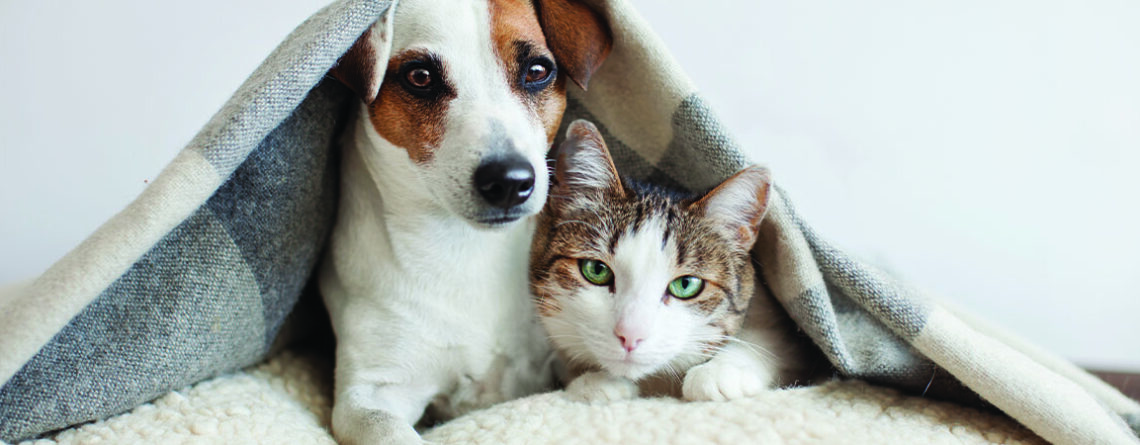Managing stress & anxiety in your pet
It’s normal for your pet to feel stressed from time to time. But too much stress can result in longer term problems with their behaviour, such as anxiety.
Knowing how to spot anxiety in your dog or cat is the first step to helping them overcome their fears. By removing whatever is causing the anxiety and taking your furry friend out of the situation, or managing the stress in other ways, we can prevent your pet from developing more established fears and help keep everyone in the family, including your pet, feeling safe.
Types of Anxiety
Fear-related anxiety can be caused by loud noises such as fireworks, new people or animals, or specific situations — like the vet’s office or car rides. Fear-related anxiety may also be triggered if your dog or cat notices something that reminds them of a past experience they might find scary.
Separation anxiety is when our pets are unable to find comfort when they are left alone or separated from their family members. This anxiety often manifests itself in destructive behaviours, such as urinating and defecating in the house, destroying furniture and furnishings, or excessive barking/meowing.
Age-related anxiety affects older dogs and cats, and can be associated with cognitive dysfunction syndrome (CDS). This is when their memory, learning, perception, and awareness start to decline, similar to the early stages of Alzheimer’s disease in humans. This understandably leads to confusion and anxiety in our senior pets.

Signs of Anxiety in Dogs
- Aggression
- Drooling
- Panting
- Urinating or defecating in the house
- Destructive behavior such as digging, chewing furniture
- Depression
- Excessive barking or howling
- Pacing or trembling
- Restlessness
Signs of Anxiety in Cats
- Defecating outside the litter box
- Suddenly being destructive
- Increased/reduced appetite
- Hiding/pacing
- Crouching defensively
- New aggressive or overly clingy behavior
- Execessive meowing
- Increased lethargy
- Coat changes e.g. bald patches from over-grooming
- Vomiting or diarrhoea

Treating Stress & Anxiety
1.Create a stimulating environment
Creating a more interesting environment can help to keep your pet mentally stimulated while you’re out of the house. For dogs, make sure to leave lots of engaging toys around the house for them to play with before you head out. For cats, cat perches with visually stimulating views and a range of toys will all help to keep them busy while you’re away.
2. Calming Products
If your pet gets very anxious, there are many ways to help ease stress and anxiety through a range of calming aids. Hemp Heros uses hemp oil in their products which is commonly used on animals to ease pain, support sleep and appetite, while reducing stress and anxiety.
You can also try a Pheromone Plug-In Diffuser, such as Adaptil. Locate the plug diffuser in room where your pet’s safe space will be. This diffuser helps with separation anxiety as well as fireworks, loud weather, new home, bereavement, a new pet in home, and any other stressful circumstances for your pet.
3. Leave quietly
This is one of the most important tips when dealing with anxiety in our pets, especially seperation anxiety. Where we all love to say goodbye to our furry friends, this really only tends to make us feel better and for your pet, it’s just telling them that you’re leaving them. When you have to leave the house, simply grab your things and head out without any fuss, as this will show your pet that it’s completely normal and not give them enough time to build up feelings of anxiety.
4. Don’t make any drastic changes in the home
If your pet is a golden oldie and is suddenly experiencing age-related anxiety, try not to make any new changes to your home environment that may startle them. Older dogs and cats are prone to vision loss, and conditions such as cataracts, glaucoma and retinal detachment can begin to develop. Avoid moving around furniture if your pet’s eyesight is failing, as this could throw them off their course and turn into an obstacle.
5. Underlying illness
Underlying illness or pain can contribute to fear or anxiety and should be considered if your adult or senior dog or cat develops a new or heightened fear response to a trigger. Senior pets may experience sensory changes that alter their perception of stimuli. If you suspect your pet be ill, please see your vet.


